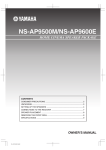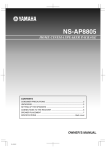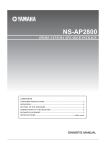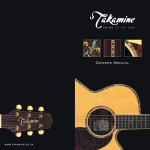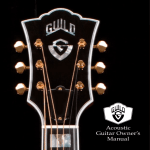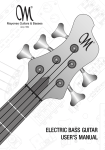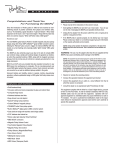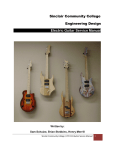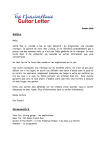Download Yamaha AW570WH - Left / Right CH Speakers Specifications
Transcript
NS-AW570 INDOOR / OUTDOOR SPEAKER SYSTEM CONTENTS CONSUMER PRECAUTIONS UNPACKING ATTACHING THE GRILLE MOUNTING THE SPEAKERS CONNECTIONS TO YOUR AMPLIFIER SETTING UP THE SPEAKERS PAINTING THE SPEAKER CASING AND GRILLE (OPTIONAL) SPECIFICATIONS 2 3 4 4 6 7 8 9 OWNER’S MANUAL CONSUMER PRECAUTIONS Read these precautions carefully before setting up your NS-AW570 speakers. • When installing these speakers outdoors, try to minimize their exposure to rain and snow by mounting the speaker in corners or under eaves. • Since these speakers can be wall mounted, it is essential that they are firmly secured. Be sure to consult a reliable source about the best type of hanger for your particular wall’s construction. Secure installation is the purchaser’s responsibility. • Do not attach them to thin plywood or soft wall surface materials as the screws may tear free, causing the speakers to fall and be damaged, or result in personal injury. • Do not fasten the speakers to walls with nails, adhesives, or other unsafe hardware. Long-term use and vibrations may cause them to pull free. • Do not place the speakers where they are liable to be knocked over or struck by falling objects. Stable placement will also ensure better sound performance. • Placing the speakers on the same stand or shelf as a turntable can result in feedback. • Never touch the woofer or tweeter units with your hands or expose them to excessive physical shock. If they are dented or bent, the sound will be distorted. • Lower the power amplifier / receiver volume control before changing input sources. Never change input sources (for example, FM to CD) at high listening levels. Always turn the receiver / amplifier unit off when installing or removing input cables. • Anytime you note distortion, reduce the volume control on your power amplifier / receiver to a lower setting. Never allow your power amplifier to be driven into “clipping”. • Do not attempt to clean the speakers with chemical solvents as this might damage the finish. To clean wipe with a dry, soft cloth. • Secure placement or installation is the owner’s responsibility. YAMAHA shall not be liable for any accident caused by improper placement or installation of speakers. 2 UNPACKING After unpacking, inspect the contents to confirm the following items are contained: Large bracket screws x 4 Speakers x 2 Screw for mega mounting plates x 2 Screw for base or for L-Bracket X 2 L-Bracket for safety chain x 2 Safety chain x 2 Protective Paint Cover x 2 Grill x 2 Bracket x 2 Glue Strips x 2 3 ATTACHING THE GRILLE When you first remove the speakers from the box they will have protective paint covers attached. Please attach the grilles to the speakers. Note These speakers are paintable. If you wish to paint the speakers, please do so before attaching the speaker grilles. Refer to “PAINTING THE SPEAKER CASING AND GRILLE” on page 8 for more information on painting the speakers. Attaching the grilles � Remove the protective paint cover from the speaker cabinet. � Align the grille with the grooves on the cabinet, then carefully push the grille edges onto the speaker cabinet. Note We recommend you use the supplied glue to guarantee that the grille is attached firmly. Apply the glue to the areas depicted in the diagram below at right. Glue strips � � Glue strips CAUTION The aluminum grilles are easy to bend out of shape. Please be careful when replacing the grille on the speaker, using only the minimum amount of force necessary. MOUNTING THE SPEAKERS The speakers can be placed on a bookshelf or wall/ceiling mounted with optional speaker brackets using 1/4 x 20 screws to fasten the optional bracket into the threaded inserts located on the back of the speakers. To wall / ceiling mount the speakers, use the supplied mounting bracket. (see below) *Secure to wall or ceiling Included mounting bracket Eaves OUTDOOR NOTE : The supplied mounting brackets allow the speakers to be mounted in corners or under eaves to minimize their exposure to rain or snow. Large bracket screws 1. Use the bracket as a template mark the locations of the key hole slots on the mounting area. 2. Next, using appropriate hardware (not included) securely fasten the bracket to the wall/ceiling. 3. Position the speaker in the bracket and secure the speaker by using the two large bracket screws included. (see above) 4 If the mega mounting plate is already installed on the outside wall, the speaker can also be mounted using the following procedure: Wall *Secure to wall or ceiling Screw Mega mounting plate Included mounting bracket Large bracket screws CAUTION Be sure to consult a reliable source for the best type of fasteners for your particular wall / ceiling construction. Secure installation is the purchaser’s responsibility. When using speaker brackets to mount the speaker on a wall, please use safety wire between the speaker and the bracket to prevent the speaker from falling. � Insert the clasp of the safety wire through the bracket and loop. � Attach the L-bracket to the speaker with screw. � � 5 CONNECTIONS TO YOUR AMPLIFIER Before making connections, make sure that the amplifier is switched off. CONNECTIONS • Connect the screw-type input terminals at the rear of the speakers to the speaker output terminals of the amplifier (or receiver) with the speaker cables. Tighten Loosen • One side of the speaker cable is red and the other side is black. Connect the (+) terminals on the amplifier (or receiver) and speakers using the red side. Connect the (-) terminals on both components using the black side of the cable. • Connect each speaker making sure not to reverse the polarity (+,-). If the speaker is connected with reversed polarity. The sound will be unnatural and lack bass. Red(+) Black(-) How to Connect: Loosen the knob. Insert the bare wire. [Remove the insulation coating at the extremity of each speaker cable by twisting the coating off.] Tighten the knob and secure the cable. Test the firmness of the connection by pulling lightly on the cable at the terminal. Note Do not let the bare speaker wires touch each other as this could damage the speaker or amplifier, or both. Speaker output terminals of the amplifier When using a banana plug Banana plug Tighten the terminal knob. Insert the banana plug into the terminal. 6 SETTING UP THE SPEAKERS INDOOR PLACEMENT You can use these speakers as front or surround speakers. — Front speaker placement should be separated by a distance of 6–10ft. If they are placed too close together, there will be a reduction in the stereo effect. Conversely, If placed too far apart, the so called “middleomission” effect will occur and the vocal center fill will be lost. Height of the speaker should beat least at ear level. — Center channel speaker should be placed centered above or below the TV. — Surround speakers should ideally be placed behind the listening area, At least as far apart as the front speakers and up to 2 additional feet apart per side. The height of the speaker should be at a minimum of ear level or preferably somewhat higher. Center channel Speaker Left front Speaker Right front Speaker 6–10 feet up to approx 2 feet more up to approx 2 feet more LISTENING AREA Left Surround Speaker Right Surround Speaker OUTDOOR PLACEMENT Your speaker system has water-resistant enclosures that protect the speakers form the elements when mounted outdoors. These speakers are designed with a wide dispersion pattern which means you will get good sound quality over a large listening area. (100 ft2 to approximately 400 ft2). Please note: if the listening area is too large, and the speakers are positioned too far apart, “middle-omission” effect (lack of sound in an area between the speakers) will occur and/or “hot spots” (loud sound near the speaker) will develop. Try to place the speakers between 6’–10’ apart for good stereo listening. It is suggested for larger areas (over 400 ft2 to about 600 ft2) two pairs of speakers be used, see below. Note 1 pair of speakers should be used for every 200–400 ft. • • 7 We recommend that you install this speaker vertically, as it is designed to ensure a wide listening area in this orientation. PAINTING THE SPEAKER CASING AND GRILLE (OPTIONAL) We have selected a speaker finish designed to blend well with almost any surroundings. However you can also paint them to obtain the perfect finish for a specific environment. Use high quality paint and select a well ventilated area before proceeding. If you are not sure what paint will be most suitable, consult a paint store professional or painter before purchase. You will need • A spray can of primer paint (Not necessary if you use plastic paint that does not require primer) • A spray can of paint in the color of your choice. Be sure to choose a grade of paint appropriate for the environment in which you wish to use the speaker. For example, use exterior-grade paint if you wish to use the speakers outdoors. • • • • A paper clip or other similar small slim device for removing the speaker grille Provided protective paint covers 2 clean cloths, one damp and one dry Masking tape Preparation 1. Remove the speaker from the speaker bracket (if the speaker is mounted in a speaker bracket). 2. Remove the grille from the loudspeaker (If they are attached). Removing the grille: Use a bent paper clip or other object with a hard tapered point inserted into the areas above and below the grille as indicated on the diagram to lift the four corners of the grille away from the speaker. 3. Using the damp cloth, wipe all surfaces of the speaker cabinet and grille clean. Do not touch the surface of the speaker baffle. Make sure that everything is dry before moving proceeding further. 4. Use masking tape to carefully mask off the screw-type input terminals at the rear of the speaker, and also to cover the the Yamaha logos on the grille. 5. Use the protective paint covers provided to carefully cover the speaker baffle. 8 Painting the cabinet 1. Apply one coat of primer to the speaker cabinet. You do not need to apply primer if you use “PAINT FOR PLASTIC” or “DIRECT-TO-PLASTIC” plastic paint marked “NO PRIMER NEEDED”. 2. Allow the first coat of primer to dry completely. 3. Apply a second coat of primer. 4. Allow the second coat of primer to dry completely. 5. Apply the finish color. 6. Allow the paint to dry completely. 7. Carefully remove all masking material. Painting the grille 1, Apply the finish color to the grille, making sure that the grille holes remain free of paint. Clogging the grille holes may diminish the sound quality. You do not need to apply any primer. 2. Allow the paint to dry completely. 3. Remount the grille on the speaker. CAUTION The aluminum grilles are easy to bend out of shape. Please be careful when replacing the grille on the speaker, using only the minimum amount of force necessary. SPECIFICATIONS Type Speaker Woofer Tweeter Frequency Range Impedance Nominal Input Maximum Input Sensitivity (dB/2.83v. 1m) Dimension (H x W x D) Weight Magnetic Shielding 2-way Acoustic Suspension 6-1/2” High Compliance P.P Mica Filled Cone and Rubber Surround 1” PEI Dome x 2 60 Hz to 30,000 Hz 6 ohms 40 W 120 W 87 dB 7-7/16” x 10-1/4” x 6-25/32” (188.67 x 260.12 x 172 mm) 5.07 lbs (2.3 kg) No *Specifications subject to change without notice due to product improvements. 9 LIMITED WARRANTY Yamaha Canada Music Ltd. (hereafter referred to as `Yamaha’) offers a one (1) year, limited warranty for this Yamaha Guitar Product and included accessories. PROOF OF PURCHASE: An authentic invoice or receipt, corresponding to the original purchase of the Yamaha Guitar Product in question, must accompany any request for in-warranty service. This invoice or receipt must clearly outline the following: - model of the Yamaha Guitar Product - name of the authorized Yamaha dealer where the Yamaha Guitar Product was purchased - date of purchase CONDITIONS: If, during the applicable period from the date of original purchase, your Yamaha Guitar Product is found, upon authorized inspection, to have a defect in material or workmanship, a Yamaha Service Center will repair such defect without charge for parts or labour. ROUTINE MAINTENANCE WORK AND THE RESULTS OF NORMAL WEAR ARE NOT COVERED BY THIS WARRANTY (see exclusions). WARRANTY PERIOD: ONE (1) YEAR PARTS AND LABOUR: Where applicable, this warranty covers: tuning hardware, tail piece, bridge, plating, pickguard, vibrato mechanisms, tops, necks, back and sides and electronics.* *Electronic coverage extends only to failure of the electrical parts and does not cover mechanical wearing issues such as worn jacks or dusty pots. This coverage extends to the guitar amplifier and/or electronic auto-tuner, if included by Yamaha in the box with your Yamaha Guitar Product. EXCLUSIONS: This warranty does NOT apply in cases involving: 1. Failures that are the result of improper operations, maintenance or repair. 2. Failures that result from abnormal strain, neglect, modification, accidental damage or exposure to extremes in temperature or relative humidity (<25% or >90%). 3. Products purchased from dealers not authorized by Yamaha to sell Yamaha Guitar Product. 4. Products whose trademark, name, or identification numbers have been altered or removed. Guitars marked "by Yamaha" are not covered by this warranty. 5. Failures traceable to repairs/modifications performed by anyone not authorized by Yamaha to perform such services. 6. Guitars no longer owned by the original purchaser. 7. Normal wear including picks, strings, frets, finish, fingerboard, accidental damage, and abuse. 8. Issues of tone. Tone is based on the subjective perception of the listener, and so particular tonal characteristics cannot be guaranteed. This warranty does NOT cover expenses incurred due to a lack of understanding of the functioning of the Guitar Product or included accessories. This warranty also does NOT cover damage(s) due to improper care and/or maintenance of the Guitar Product or included accessories. www.yamaha.ca 10 YAMAHA CANADA MUSIC LTD. 135 MILNER AVE., SCARBOROUGH, ONTARIO M1S 3R1, CANADA












